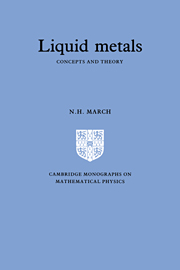Book contents
- Frontmatter
- Contents
- Preface
- 1 Outline
- 2 Pair correlation function and structure factor of ions
- 3 Thermodynamics
- 4 Electron screening and effective ion-ion interactions
- 5 Interionic forces and structural theories
- 6 Statistical mechanics of inhomogeneous systems and freezing theory
- 7 Electronic and atomic transport
- 8 Hydrodynamic limits of correlation functions and neutron scattering
- 9 Critical behaviour
- 10 Electron states, including critical region
- 11 Magnetism of normal and especially of expanded liquid metals
- 12 Liquid-vapour surface
- 13 Binary liquid-metal alloys
- 14 Two-component theory of pure liquid metals
- 15 Shock-wave studies
- 16 Liquid hydrogen plasmas and constitution of Jupiter
- Appendices
- References
- Index
15 - Shock-wave studies
Published online by Cambridge University Press: 19 January 2010
- Frontmatter
- Contents
- Preface
- 1 Outline
- 2 Pair correlation function and structure factor of ions
- 3 Thermodynamics
- 4 Electron screening and effective ion-ion interactions
- 5 Interionic forces and structural theories
- 6 Statistical mechanics of inhomogeneous systems and freezing theory
- 7 Electronic and atomic transport
- 8 Hydrodynamic limits of correlation functions and neutron scattering
- 9 Critical behaviour
- 10 Electron states, including critical region
- 11 Magnetism of normal and especially of expanded liquid metals
- 12 Liquid-vapour surface
- 13 Binary liquid-metal alloys
- 14 Two-component theory of pure liquid metals
- 15 Shock-wave studies
- 16 Liquid hydrogen plasmas and constitution of Jupiter
- Appendices
- References
- Index
Summary
In this chapter, the focus is the study of the properties of liquid metals at high pressure and temperature, with special emphasis on shock-wave studies. Naturally, theory can be invoked to bring the experimental observations into contact with what has been learned about liquid metals in the earlier chapters. Then, in the concluding chapter, some emphasis is placed on the relevance of such properties of the lightest and most abundant elements, H and He, in considering the giant planets Jupiter and Saturn.
In a shock-wave experiment, one measures the shock and particle velocities; from these, the pressure and density of the final state can be obtained directly. For some materials, it is also possible to measure temperature and optical properties. But, in the main, detailed information about atomic and molecular processes must come from theoretical studies.
In Section 15.2 the fundamental relations of shock physics are introduced. This is followed by a discussion of some specific results on hot expanded metals: data necessarily limited by large binding energies and high values of the critical constants.
Shock compression
Here some of the essential physics of shock compression are summarized, following the account of Ross (1985). A shock wave is a disturbance propagating at supersonic speed in a material, preceded by an extremely rapid rise in pressure, density, and temperature. It seems natural, at first sight, to associate shock waves with explosions and other uncontrolled and irreversible processes. Although shock waves are irreversible, the process is well understood and can be controlled to produce a desired response.
- Type
- Chapter
- Information
- Liquid MetalsConcepts and Theory, pp. 303 - 308Publisher: Cambridge University PressPrint publication year: 1990



